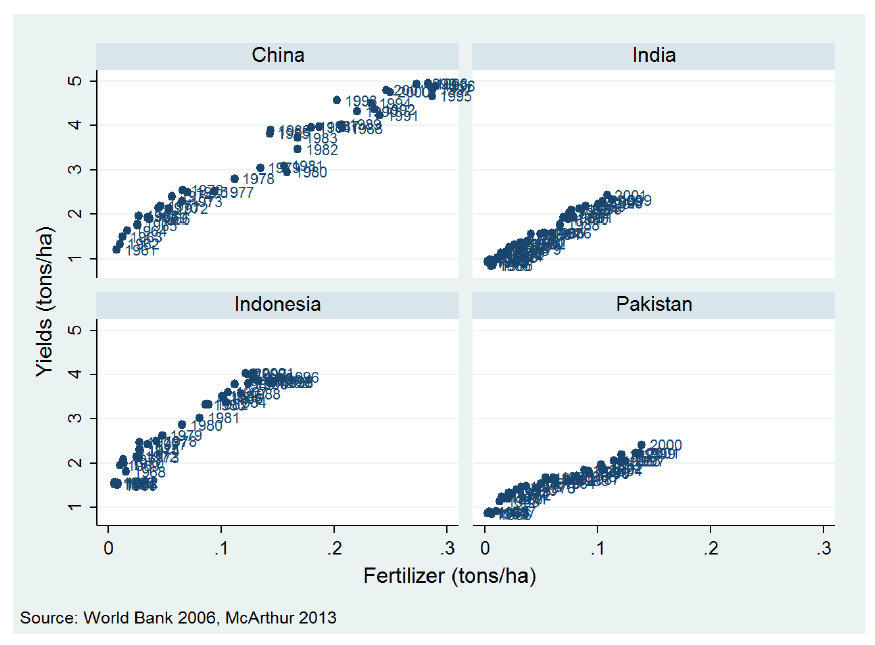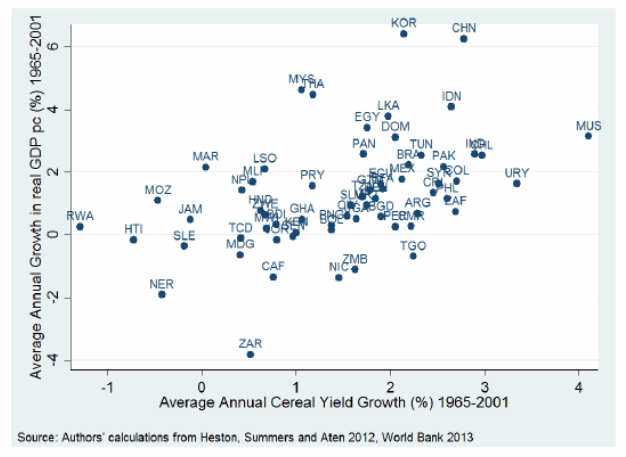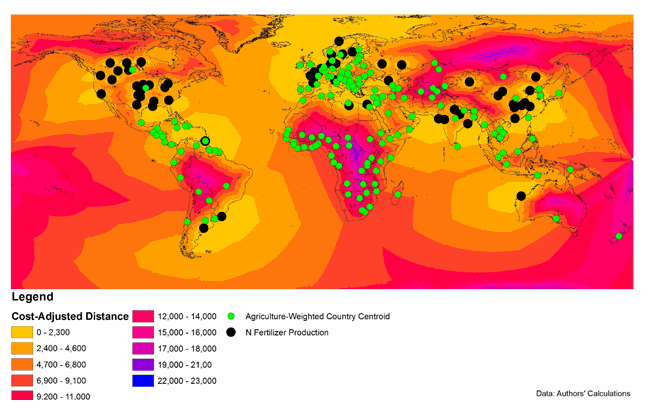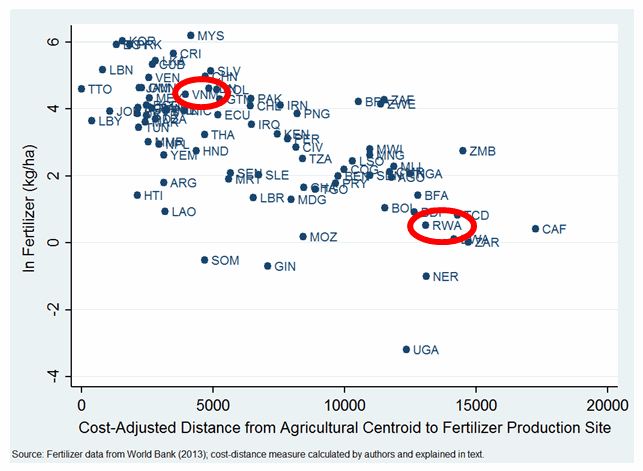What role does agriculture play in structural change? In other words, how does agriculture affect the long-term societal process whereby labor moves from low productivity rural food production to higher productivity urban sectors like manufacturing and services? Moreover, how can we unpack the black box of agriculture to understand the components that lead to its progress in the first place? Our new working paper, “Fertilizing Growth: Agricultural Inputs and their Effects in Economic Development,” provides new evidence to help answer these questions.
The Debate
Scholars often disagree on the role of agriculture in structural change. Some argue that societies have a first-order need to feed themselves, so increases in agricultural labor productivity are a necessary precursor to the labor force shifting from agriculture into other sectors that offer higher incomes. Advocates for this perspective point towards the Green Revolution in Asia as a precursor to its subsequent rapid economic growth.
[1]
Others argue that the last half-century’s success of export-oriented developing economies plus the globalized market for food trade suggest that countries should focus their scarce public resources on fostering manufacturing sectors that can absorb the labor force that was previously so unproductive in the rural areas. This and other evidence regarding agriculture’s relatively low value added per worker compared to other sectors has prompted some researchers to recommend agriculture as a priority sector for fewer and fewer developing countries in light of higher prospective growth returns in non-agricultural sectors.
One reason for the difficulty in identifying the causal role of agricultural productivity on structural change is that the relevant indicators trend together in the process of development. As per Figures 1 and 2, an increase in fertilizer use might occur alongside increased crop yields and decreasing labor shares in agriculture, but that doesn’t mean that an increase in fertilizer use is driving those changes. It is possible, for example, that increasing urban incomes lead to increased food prices, which allow farmers to invest in more fertilizer—implying that the structural change is driven by urban productivity growth.
Figure 1:
Yields and Fertilizer Use, Selected Developing Countries, 1961-2001

Figure 2: Growth in GDP Per Capita Versus Growth in Cereal Yields, 1965-2001

New Evidence
Our paper considers the role of agricultural inputs as drivers of higher yields and subsequent economic transformation. The main contribution of the paper is a novel instrument for fertilizer use that can enable causal claims for the effects of fertilizer use on yields, income growth, labor shifts out of agriculture, and subsequent increases in labor productivity outside of agriculture. A valid instrument needs to be correlated with countries’ fertilizer use and satisfy the exclusion restriction of not affecting yields through any channel besides fertilizer use. We use fluctuations in the global fertilizer price to generate temporal variation exogenous to conditions in any one developing country. In order to generate the instrument’s cross-country variation we exploit the fact that the production of nitrogen fertilizer is intensive in natural gas usage and therefore produced in only a select number of locations around the world, most of which are in developed countries.
The instrument is constructed by using a Geographic Information System (GIS) to calculate the agriculturally-weighted centroid of each country, using data on the percentage of each 5 arc-minute grid cell’s area planted to staple crops (maize, wheat, rice, sorghum or millet). Next, we mapped the facilities of the world’s top nitrogen fertilizer companies, and then calculated the minimum cost-adjusted distance from each country’s agriculturally-weighted centroid to the nearest fertilizer production site, using a 1:7 transport cost ratio to optimize travel over sea versus travel over land, in line with previous evidence around land-ocean transport costs. The centroids, fertilizer production sites and optimal cost-distance function are mapped below.
Figure 3: Cost-Adjusted Distance to Major Fertilizer Production Sites

The distance component of the instrumental variable is itself strongly correlated with fertilizer use across countries, as shown in Figure 4 below, which plots the log of fertilizer use per hectare at the 1985 sample midpoint against the indexed distance measure. Towards the top left of the scatter plot, a country like Vietnam has an distance index value of 3,954 and uses 84 kg/ha of fertilizer, while Rwanda, towards the bottom right, has a distance value of 13,083 and fertilizer use of 1.7 kg/ha.
Figure 4: Fertilizer Use in 1985 and Indexed Cost-Distance to Fertilizer Production Sites

With the help of this novel instrument, our cross-country econometric strategy proceeds in two parts. First, we assess the inputs that contributed to increased productivity in staple agriculture, as proxied by cereal yields per hectare, from 1960-200. We find evidence for fertilizer, modern variety seeds and water as key inputs to yield growth, controlling for other factors such as human capital and land-labor ratios. Specifically, we find that a representative country with yields of 1.5 tons per hectare that introduces an input package to jump from, say, 15 kg per hectare to 65 kg per hectare (0.05 tons) of fertilizer use would be expected to see an average yield jump of 0.15-0.47 tons per hectare; while increasing from 10 to 50 percent use of modern seed would be expected to increase yields by approximately 0.48 tons per hectare.
Second, we deploy the instrument to examine the causal link between changes in cereal yields and aggregate economic outcomes, including gross domestic product (GDP) per capita, labor share in agriculture, and non-agricultural value added per worker. We find evidence that increases in cereal yields have both direct and indirect positive effects on economy-wide outcomes. Results suggest that a half ton increase in staple yields generates a 13-19 percent higher GDP per capita, a 3.3-3.9 percentage point lower labor share in agriculture five years later, and approximately 20 percent higher non-agricultural value added per worker a decade later. This last finding for non-agricultural value added is not significant at standard 5 percent levels in all specifications, but our exploration of the time lags is suggestive that the relevant coefficient is not zero.
The structural change literature has struggled to identify causal effects given the economy-wide nature of the transformation and the fact that the process takes decades. This paper offers an empirical strategy that provides evidence of strong causal effects on yield and economic growth resulting from adoption of a green revolution-type package of inputs in economies with low agricultural productivity and a large share of the labor force still in agriculture. At a minimum the results provide a clear counterpoint to arguments for “pull only” strategies that focus on manufacturing and service sectors as the sole drivers of economic growth. The evidence suggests a particularly strong role for fertilizer and fertilizer-responsive modern variety seeds, which is highly consistent with field station agronomic research. Fertilizer’s high private return both in experimental plots and in the field suggest some sort of market failure that policy can address. Scholars debate whether the failure is due to credit constraints or non-rational behavior on the part of farmers.[2]
Regardless, the evidence presented in this paper suggests social returns from fertilizer that exceed the immediate private returns, furthering the case for policy efforts.
Gordon C. McCord is an assistant professor at the School of International Relations & Pacific Studies at the University of California, San Diego. He can be reached at [email protected].
[1] Duflo, Esther, Michael Kremer, and Jonathan Robinson. 2008. “Psychology and Development: Theory and Experimental Evidence.” American Economic Review: Papers and Proceedings 482-488.
[2] Sachs, Jeffrey D. 2005. The End of Poverty: Economic Implications for Our Time. New York: Penguin.
The Brookings Institution is committed to quality, independence, and impact.
We are supported by a diverse array of funders. In line with our values and policies, each Brookings publication represents the sole views of its author(s).



Commentary
New Evidence on Fertilizer, Agricultural Yields, and Structural Change
October 28, 2014